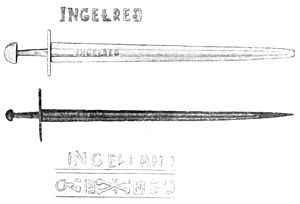
Pattern welding is the practice in sword and knife making of forming a blade of several metal pieces of differing composition that are forge-welded together and twisted and manipulated to form a pattern. Often mistakenly called Damascus steel, blades forged in this manner often display bands of slightly different patterning along their entire length. These bands can be highlighted for cosmetic purposes by proper polishing or acid etching. Pattern welding was an outgrowth of laminated or piled steel, a similar technique used to combine steels of different carbon contents, providing a desired mix of hardness and toughness. Although modern steelmaking processes negate the need to blend different steels, pattern welded steel is still used by custom knifemakers for the cosmetic effects it produces.

A longsword is a type of European sword characterized as having a cruciform hilt with a grip for primarily two-handed use, a straight double-edged blade of around 80 to 110 cm, and weighing approximately 1 to 1.5 kg.
A flame-bladed sword or wave-bladed sword has a characteristically undulating style of blade. The wave in the blade is often considered to contribute a flame-like quality to the appearance of a sword. The dents on the blade can appear parallel or in a zig-zag manner. The two most common flame-bladed swords are rapiers or Zweihänders. A flame-bladed sword was not exclusive to a certain country or region. The style of blade can be found on swords from modern-day Germany, France, Spain, and Switzerland.
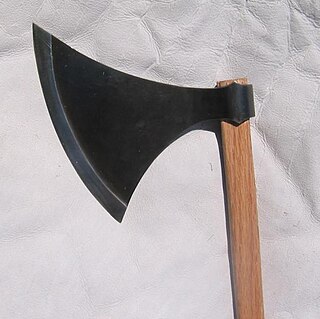
The Dane axe is an early type of battle axe, primarily used during the transition between the European Viking Age and early Middle Ages. Other names for the weapon include English long axe, Danish axe, and hafted axe.
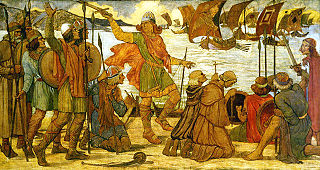
Knowledge about military technology of the Viking Age is based on relatively sparse archaeological finds, pictorial representation, and to some extent on the accounts in the Norse sagas and laws recorded in the 14th century.

Hilda Roderick Ellis Davidson was an English folklorist. She was a scholar at the University of Cambridge and The Folklore Society, and specialized in the study of Celtic and Germanic religion and folklore.
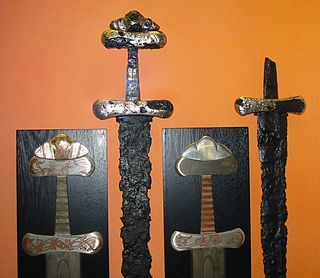
The Viking Age sword or Carolingian sword is the type of sword prevalent in Western and Northern Europe during the Early Middle Ages.
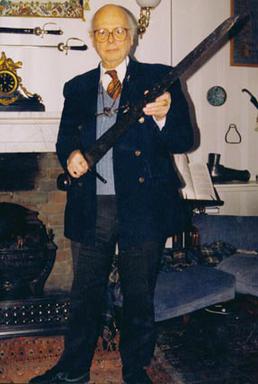
Ronald Ewart Oakeshott was a British illustrator, collector, and amateur historian who wrote prodigiously on medieval arms and armour. He was a Fellow of the Society of Antiquaries, a Founder Member of the Arms and Armour Society, and the Founder of the Oakeshott Institute. He created a classification system of the medieval sword, the Oakeshott typology, a systematic organization of medieval weaponry.

The Oakeshott typology is a way to define and catalogue the medieval sword based on physical form. It categorises the swords of the European Middle Ages into 13 main types, labelled X through XXII. The historian and illustrator Ewart Oakeshott introduced it in his 1960 treatise The Archaeology of Weapons: Arms and Armour from Prehistory to the Age of Chivalry.

On a sword, the crossguard, or cross-guard, the individual bars on either side known as quillon, is a bar of metal at right angles to the blade, placed between the blade and the hilt.

Chape has had various meanings in English, but the predominant one is a protective fitting at the bottom of a scabbard or sheath for a sword or dagger. Historic blade weapons often had leather scabbards with metal fittings at either end, sometimes decorated. These are generally either in some sort of U shape, protecting the edges only, or a pocket shape covering the sides of the scabbard as well. The reinforced end of a single-piece metal scabbard can also be called the chape.
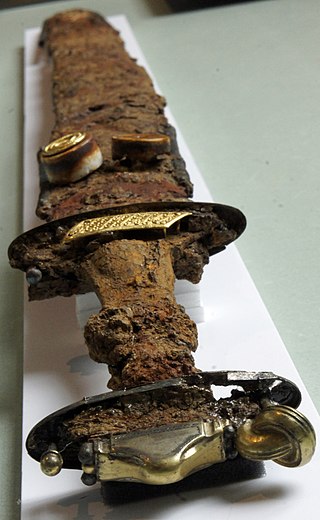
The Migration Period sword was a type of sword popular during the Migration Period and the Merovingian period of European history, particularly among the Germanic peoples. It later gave rise to the Carolingian or Viking sword type of the 8th to 11th centuries AD.

The Cawood sword is a medieval sword discovered in the River Ouse near Cawood in North Yorkshire in the late 19th century. The blade is of Oakeshott type XII and has inscriptions on both sides. It most likely dates to the early 12th century.

An atgeir, sometimes called a "mail-piercer" or "hewing-spear", was a type of polearm in use in Viking Age Scandinavia and Norse colonies in the British Isles and Iceland. The word is related to the Old Norse geirr, meaning spear. It is usually translated in English as "halberd", but most likely closer resembled a bill or glaive during the Viking age. Another view is that the term had no association with a specific weapon until it is used as an anachronism in saga literature to lend weight to accounts of special weapons. Later the word was used for typical European halberds, and even later multipurpose staves with spearheads were called atgeirsstafir.
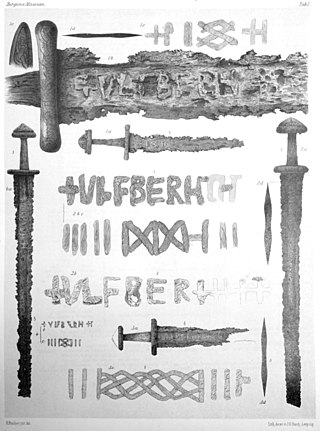
The Ulfberht swords are a group of about 170 medieval swords found primarily in Northern Europe, dated to the 9th to 11th centuries, with blades inlaid with the inscription +VLFBERH+T or +VLFBERHT+. The word "Ulfberht" is a Frankish personal name, possibly indicating the origin of the blades.

The swastika design is known from artefacts of various cultures since the Neolithic, and it recurs with some frequency on artefacts dated to the Germanic Iron Age, i.e. the Migration period to Viking Age period in Scandinavia, including the Vendel era in Sweden, attested from as early as the 3rd century in Elder Futhark inscriptions and as late as the 9th century on Viking Age image stones.

The basket-hilted sword is a sword type of the early modern era characterised by a basket-shaped guard that protects the hand. The basket hilt is a development of the quillons added to swords' crossguards since the Late Middle Ages. In modern times, this variety of sword is also sometimes referred to as the broadsword.
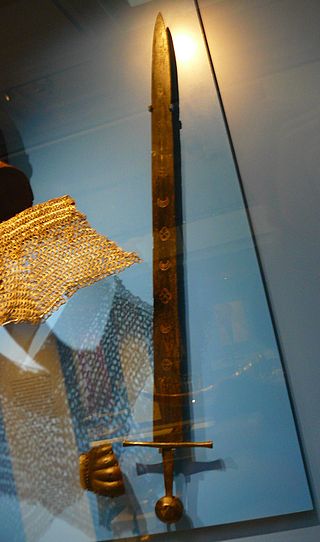
In the European High Middle Ages, the typical sword was a straight, double-edged weapon with a single-handed, cruciform hilt and a blade length of about 70 to 80 centimetres. This type is frequently depicted in period artwork, and numerous examples have been preserved archaeologically.
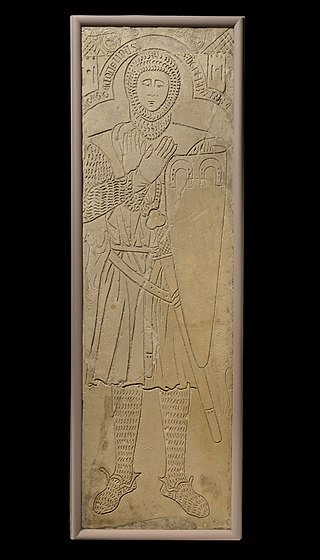
The Tomb Effigy of Jacquelin de Ferrière is usually on display in the Medieval Art Gallery of the Metropolitan Museum of Art in New York. The effigy is of the French knight, Sir Jacquelin de Ferrière, who was from Montargis, near Sens in northern France. The effigy is dated between 1275-1300 CE. It is 73+3⁄4 in (187 cm) long, 24+5⁄8 in (63 cm) wide, and 5 inches (13 cm) deep, and carved into a flat limestone slab, which now has a wooden frame. Effigies were often commissioned by the nobles or their families, as a means of remembrance. They would normally be found covering the sarcophagi of the knight, or installed in or near a church that the family were patrons of. Although the inscription on this effigy is not clear, most effigies contained similar inscriptions that would include the name and title, dates of birth and death–or approximates, a link between the date of death and a notable holy figure or day, and petitions of prayer that would offer pardons to those that prayed for the depicted soul–largely an attempt to create a tangible link between the nobility and divinity.
